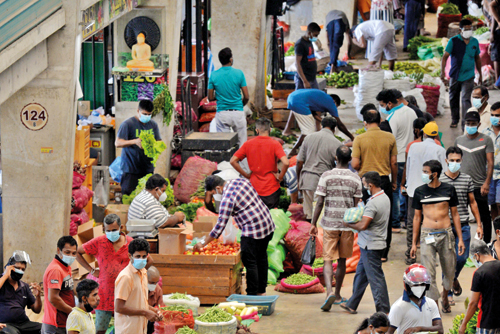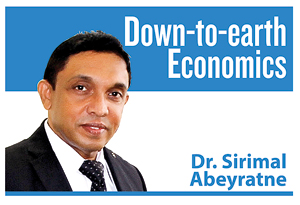Bitter policy dose after vaccines
View(s):
A market in Sri Lanka where vegetable prices have risen.
A few weeks ago, the Central Bank of Sri Lanka decided to reverse its monetary policy stance that it had been implementing over the past one and half years; instead of “loosening” monetary policy, now it is one of “tightening”. Reuters reported that “Sri Lanka becomes the first in Asia” to do so. However, some of the countries including South Korea, Singapore, Iceland, Mexico and Brazil have already moved in this direction so that it doesn’t look like an exclusive policy decision by Sri Lanka only. In the coming months we would be able to see this reversing trend globally.
Even the Federal Reserve Bank of the US signaled that it is likely to begin tapering its current loose monetary policy before the end of the year. Although the EU is not yet ready for a “premature” monetary policy tightening, it doesn’t appear to be a unanimous decision by all its member states, while it continues as a source of debate. Whatever the decisions of the European Central Bank may be, the EU will have to respond to the changing monetary policy stance of the US, if it is likely to begin the monetary policy tapering towards the end of the year.
Tightening monetary policy
What is going on? And what are the implications for us? Before we try to find answers to these questions, let me elaborate on the decisions made by the Central Bank: With an effective date starting from September 1, the Central Bank raised its policy rates by 50 basis points and the Statutory Reserve Ratio (SRR) by 2 percentage points. As an important monetary policy tool at hand, the policy rates are the Standing Deposit Facility Rate (SDFR) which increased from 4.5 to 5 percent and the Standing Lending Facility Rate (SLFR) from 5.5 to 6 percent; in some other countries these two policy rates are referred to as repo and reverse repo rates. At the SDFR or repo rate, the central banks can accept excess liquidity of the commercial banks as short-term deposits, while at SLFR or the reverse repo rate central banks can lend short-term liquidity to them whenever they have cash shortages.
Along with policy rates, the Bank Rate (which is also called in some other countries as Discount Rate) at which the commercial banks can have access to Central Bank’s short-term collateralized loans as the last resort; as per tightened monetary policy, this rate also went up from 8.5 percent to 9 percent. In addition, the SRR which remained so far as 2 percent was doubled to 4 percent; this is a deposit liability that the Central Bank imposed on current accounts and savings accounts of the commercial banks so that they are required to deposit that proportion of cash with the Central Bank.
 What does these monetary policy decisions mean as their policy objectives? Their effects are expected to channel to the economy in the form of constraining bank credits and raising the interest rates, if the channeling path works smoothly. Although it is too early to see the effects on bank credit expansion, we have already seen the rising interest rates in the banking system. The question is, why do we need it right now?
What does these monetary policy decisions mean as their policy objectives? Their effects are expected to channel to the economy in the form of constraining bank credits and raising the interest rates, if the channeling path works smoothly. Although it is too early to see the effects on bank credit expansion, we have already seen the rising interest rates in the banking system. The question is, why do we need it right now?
Vaccination and inflation
Let me turn to the global economy first. With the accelerated COVID-19 vaccine campaign in the world, the signs of a global economic recovery are already emerging. It is the biggest world vaccination campaign in the history; more than 5.5 billion doses have been already administered across the world, as reported by Bloomberg a few days ago. The vaccination rate was moving around 37 million doses a day; at this rate, in another five months’ time, 75 percent of the world population would have been vaccinated – that may be the whole adult population in the world.
It is the high-income countries which have been fast-moving in the vaccination programme while most of these countries have already vaccinated about 50 – 70 percent of their population with two doses. Many developing countries are behind them, but some of them including Sri Lanka have already vaccinated over 40 percent of population with a double dose.
There is a relationship between the vaccination campaign, consumer demand and resulting inflation. No need to get confused as it is not the vaccine that has caused inflation; it is the vaccine that has helped the countries to relive their lockdown status and to open the space for economic activities to revive. It is in this context that consumer demand and prices are both are on the rise.
The vaccination campaign coupled with the government spending supported by monetary policy stimulus, have contributed to bounce back the global economy. As per the latest growth projections of the IMF, the world economy which contracted by 3.2 percent in 2020 is estimated to grow by 6 percent in 2021 – advanced countries by 5.6 percent with the highest rates of growth in the US and the UK and, developing countries by 6.3 percent with the highest rates of growth in China and India.
Rate of Real GDP Growth (%):
2021 Projections:
Advanced countries- 5.6 %
US 7.0
UK 7.0
Developing countries 6.3
China 8.1
India 9.5
World 6.0
Source: IMF, World Economic
Outlook (July 2021)
Tightening belts
The unprecedented growth projection for the US economy of 7 percent is also supported by its massive US$1.9 trillion expenditure plan. The renewed expansion of the US economy, whatever its ultimate outcome would be, is expected to reverberate across the world through its renewed impact on world trade and investment as well as its implications on inflation and interest rates. When the EU joins with its economic recovery and when Asia is leading with the higher rates of growth in China and India, some would stand to benefit, while others may have to tighten their belts.
What does the economic recovery in both advanced countries and large economies means for the others – particularly the developing countries? Generally, the effects are two-fold: The first is the increased aggregate demand – both consumer demand and business demand – and, its impact on trade and investment in developing countries. This means that developing countries can benefit from the expanding world economy.
Well, it’s true; what we are talking about here is the “spillover” effects of the world economic recovery. However, even to benefit from the spillover effects of somewhere else, the recipient countries must be prepared for that. How much would be the spillover benefits for individual countries depends on how much they are prepared for that.
The second is a challenge that developing countries have to face in terms of rising world prices and interest rates. These factors, combined with domestic policy issues, would compel the countries to resort to unpopular policies. Thus, increased government spending and money printing will no longer be feasible as scapegoats; rather these pandemic policy measures would have to be reversed as the Central Banks must take steps to keep rising aggregate demand and inflationary pressure under control. It is the net outcome of the above two-fold policy implications that the individual countries will have to face ultimately.
Growth beyond recovery
Since the outbreak of the COVID-19 pandemic last year, Sri Lanka has adopted a relaxed monetary policy stance resulting in historically low policy rates and reserve ratios along with increased money printing. Along with growing inflationary pressure in general and the double-digit food inflation rate in particular, it is time to return to the primary objective of the central bank – price stability. While it would also ease pressure on the exchange rate, a resulting new challenge would be the need for fiscal consolidation from both dimensions – taxation and spending.
What about benefits from trade and investment? Of course, if we are prepared for that, we would also experience new export growth and investment flows. It is the key for Sri Lanka to ensure long-term growth beyond recovery, leaving the monetary policy to play its part.
(The writer is a Professor of Economics at the University of Colombo and can be reached at
sirimal@econ.cmb.ac.lk and follow on Twitter @SirimalAshoka).


